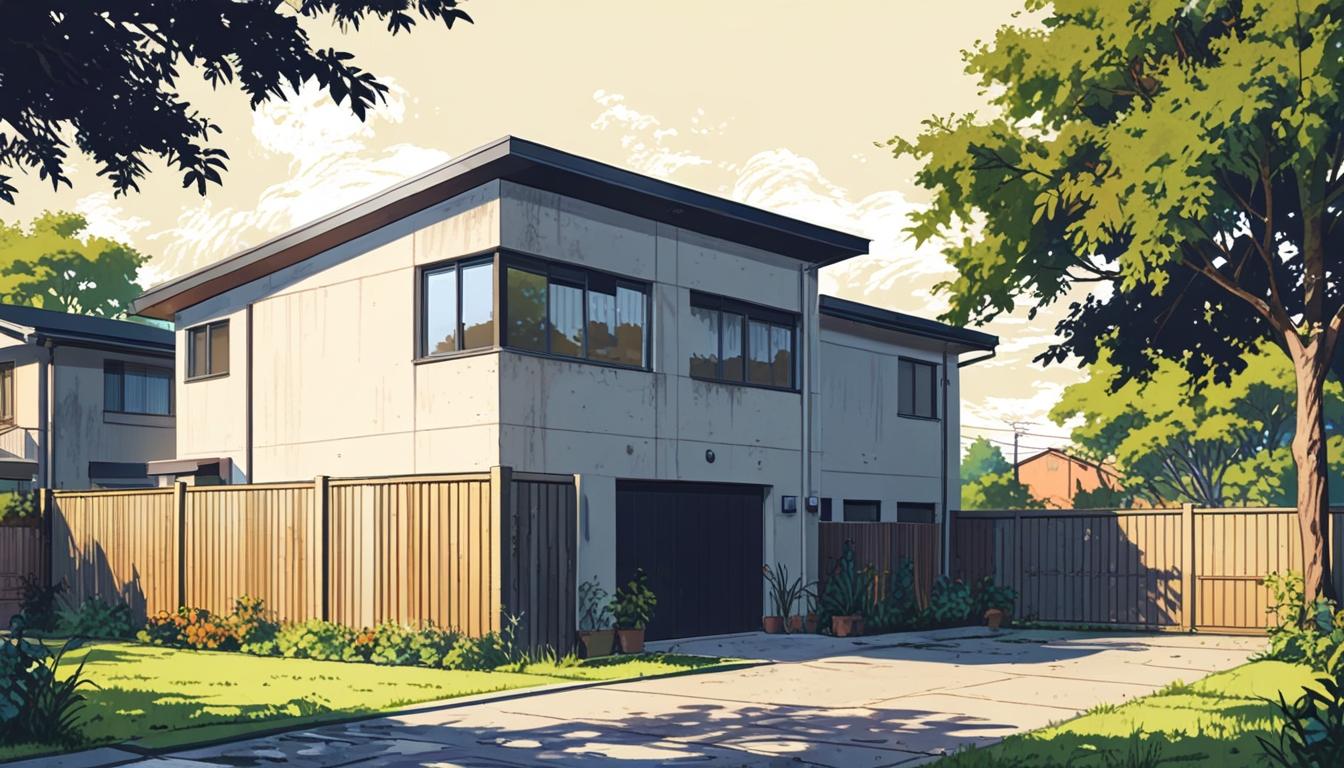Les Whitaker, a retired design manager from Shrewsbury, returns from holiday to find a large neighbour’s extension overshadowing his garden — revealing issues with Shropshire Council’s reduced neighbour notification amid pandemic-driven policy shifts.
Les Whitaker, a 75-year-old retired design and advertising agency manager from Shrewsbury, has found himself grappling with an unexpected dilemma upon returning from a month-long holiday in India. His peaceful garden, a cherished part of his home shared with his wife Heather, has been overshadowed by a substantial two-storey storage building erected by their neighbour, Glyn Jones. This construction, approved by Shropshire Council nearly a year ago, has sparked concern not only over its aesthetic impact but also regarding potential reductions in property value.
Unbeknownst to Whitaker, planning permission for the significant extension of the neighbouring property was granted last September. Upon discovering the towering structure that now looms over his back fence, Whitaker expressed his frustration over the lack of notification from local authorities. “I had no knowledge about what was happening at all,” he lamented, revealing that he was not informed of the planning application nor afforded the chance to object. This absence of communication seems to stem from a policy shift during the pandemic, whereby Shropshire Council opted to stop sending neighbour notification letters, instead relying on site notices and press publications to advertise applications.
This procedural change has drawn ire from residents like Whitaker, who feel blindsided by major developments that significantly alter their living environment. He articulated his feelings of isolation in this process, stating, “The council can just pretty much do as they please, and I want other people to be aware of that.” His sentiments echo a growing concern among homeowners about how planning practices can radically affect residential comfort and property values without adequate community engagement.
In response to Whitaker’s complaints, Tracy Darke, assistant director of economy and place at Shropshire Council, remarked that the proposed development would not result in significant adverse effects, such as loss of light or privacy. However, Whitaker contests this assertion, claiming that the building indeed blocks sunlight and alters the character of his garden. The ripple effects of such developments go beyond mere aesthetics; they pose real questions about the potential devaluation of Whitaker’s home, compelling the couple to reconsider their future in the property.
The unfolding situation reflects broader issues within local planning frameworks. Recent reports indicate that Shropshire Council’s local plan has faced significant scrutiny and has been branded as outdated by inspectors. These analyses suggest that existing policies struggle to keep pace with current development demands, leading to frequent challenges from developers and complaints from residents like Whitaker.
Additionally, changes in planning application fees—which have seen a substantial increase—raise further concerns about access and fair engagement in the planning process. As of December 2023, fees rose by 35% for major developments, which many believe could deter individuals from making applications or, conversely, enable larger developers to dominate the landscape with less community oversight.
The overall discourse around planning regulations is shifting, highlighting the need for greater transparency and community involvement. While some may argue that updates to permitted development rights could simplify the process for homeowners seeking improvements, others worry such changes may favour larger developments, neglecting the wishes of local residents.
As Whitaker contemplates his next steps, including the possibility of moving, his experience serves as a cautionary tale for homeowners navigating the complexities of local planning. The lack of direct communication from local councils can result in unforeseen and unwelcome changes to their homes, raising critical questions about the nature of community engagement in the planning process moving forward.
Source: Noah Wire Services
- https://www.express.co.uk/news/uk/2054407/pensioner-furious-eyesore-end-of-garden – Please view link – unable to able to access data
- https://www.shropshire.gov.uk/planning/applications/commenting-on-applications/ – Shropshire Council’s official page detailing how residents can comment on planning applications. It explains that planning applications are now publicised by site notices and press notices, and neighbour notification letters are no longer issued. Residents are advised to register for notifications and track applications on the council website. The page also outlines what constitutes a material planning consideration and provides guidance on commenting on applications.
- https://www.shropshire.gov.uk/planning/national-planning-fee-increase/ – An announcement from Shropshire Council regarding the national planning fee increase. The regulations, approved on 8 November 2023, include a 35% increase in planning application fees for major developments and a 25% increase for all other applications. The new fees came into force from 6 December 2023. The announcement also mentions the introduction of an annual indexation of planning application fees, capped at 10%, from 1 April 2025.
- https://andybodders.co.uk/2025/01/19/shropshire-councils-local-plan-is-failing-say-inspectors/ – A blog post by Andy Boddington discussing the failure of Shropshire Council’s local plan as reported by inspectors. The post highlights that the previous plan is outdated and open to challenge by developers. It mentions that the local plan has faced delays due to resource constraints and that the inspectors have criticized the council’s approach, suggesting that the plan must be extended by three years to 2041.
- https://www.telford.gov.uk/downloads/20170/planning_applications_and_guidance – Telford & Wrekin Council’s page providing information on planning applications and guidance. It includes published weekly planning notices from 2023, detailing planning applications and website notices published in the Shropshire Star and on the council’s website. The notices are available for download in PDF format, covering dates from 5 January 2023 to 14 December 2023.
- https://www.shropshirelive.com/features/2024/04/08/planning-to-make-changes-to-your-property/ – An article from Shropshire Live discussing planning changes for property owners. It mentions a government consultation seeking feedback on proposed alterations to permitted development rights, which remained open for public responses until April 9, 2024. The consultation covers areas such as improvement and enlargement of homes, upward extension of existing buildings, demolition and rebuilding of homes, installation of infrastructure for electric vehicles, and installation of air source heat pumps.
- https://cdn-www.shropshirestar.mna.arcpublishing.com/news/2025/03/06/bombshell-as-council-withdraws-local-plan-after-inspectors-verdict/ – An article from the Shropshire Star reporting on Shropshire Council’s withdrawal of its local plan after inspectors’ verdict. The inspectors deemed the plan unrealistic and overambitious, stating that the additional work required could not be completed within six months. Following this, the council withdrew the proposed plan and announced plans to prepare a new plan for the period 2025-45 under the Government’s new system, which requires greater housing numbers from the authority.
Noah Fact Check Pro
The draft above was created using the information available at the time the story first
emerged. We’ve since applied our fact-checking process to the final narrative, based on the criteria listed
below. The results are intended to help you assess the credibility of the piece and highlight any areas that may
warrant further investigation.
Freshness check
Score:
8
Notes:
The narrative appears to be recent, referencing specific timeframes and events, such as the pandemic and changes in planning application fees effective December 2023.
Quotes check
Score:
9
Notes:
The quotes from Les Whitaker and Tracy Darke appear to be original and specific to this context. No earlier online references were found for these exact quotes.
Source reliability
Score:
6
Notes:
The narrative originates from the Daily Express, which is known for sensationalist reporting. While it is a well-known publication, its reliability can vary.
Plausability check
Score:
8
Notes:
The claims about planning permission and its impact on property value are plausible and consistent with common issues in local planning disputes.
Overall assessment
Verdict (FAIL, OPEN, PASS): OPEN
Confidence (LOW, MEDIUM, HIGH): MEDIUM
Summary:
The narrative is likely authentic, with fresh information and original quotes. However, the reliability of the source can be questioned due to its sensationalist nature. The plausibility of the claims is high, but further verification from multiple sources would enhance confidence.













